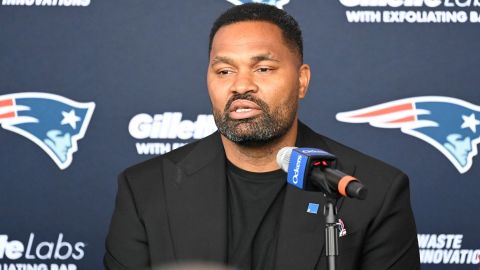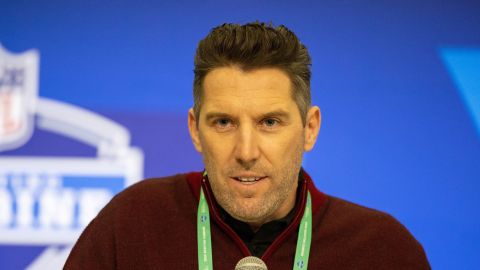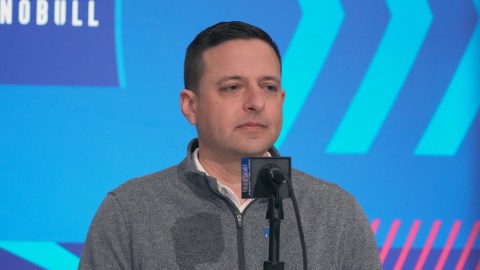 FOXBORO, Mass. — Moving a college cornerback to safety is nothing new. Neither is moving a player who has experience at cornerback in the NFL to the deep position.
FOXBORO, Mass. — Moving a college cornerback to safety is nothing new. Neither is moving a player who has experience at cornerback in the NFL to the deep position.
But New England’s Devin McCourty and Buffalo’s Jairus Byrd may make NFL teams start thinking about utilizing the conversion more often. Both players played cornerback in college (McCourty also started his Patriots career at corner) and are now two of the best cover safeties in the NFL at a time when the NFL is sorely lacking those type of players.
The Patriots know that better than most. Before McCourty made the full-time switch, New England struggled to find a fixture in the deep role. After Bill Belichick traded for Aqib Talib, the Patriots’ defensive backfield finally appeared to click — but Talib and Alfonzo Dennard starting outside at cornerback and Kyle Arrington moving to the slot full time were just part of that. McCourty going to free safety was what shored up the secondary the most.
If there was a better cover safety in the NFL last season than McCourty, it was Buffalo’s Byrd. Since being drafted No. 42 overall in 2009 — just eight picks after Patrick Chung, two picks after Ron Brace and one pick after Darius Butler — Byrd has been a two-time All-Pro and two-time Pro-Bowler. He has 18 interceptions in four seasons with Buffalo.
In today’s NFL, it makes sense to take players like McCourty and Byrd, who have the cover skills of a top-tier cornerback, and play them at free safety. They may not be as physical as an Adrian Wilson or Lawyer Milloy, but with more and more big hits being barred over the middle, the need for a safety who can intimidate a wide receiver is becoming less needed.
Safeties still need to be physical enough to guard tight ends and running backs, but covering a Rob Gronkowski or Jimmy Graham is just as much about speed as it is about strength. By nature, safeties aren’t the same type of athletes as cornerbacks. College teams will try a player at cornerback to trail a wide receiver before they’ll think to move that player back deep.
Elite safeties who played the position in college are still around and will continue to be drafted. Earl Thomas, Eric Weddle, T.J. Ward, Ed Reed and Troy Polamalu all played safety in college. But some of the top players all time at the position, like Ronnie Lott and Rod Woodson, started their careers as cornerbacks. Lately, we’ve seen older cornerbacks like Charles Woodson and Ronde Barber successfully make the transition.
Belichick is not new to the transition, either. He drafted Eugene Wilson, a college cornerback at Illinois, and moved him to safety. He did the same with former Illini Tavon Wilson in 2012. Wilson was drafted in the second round and moved to safety. He played cornerback in his freshman, sophomore and senior seasons at Illinois and safety in his junior year.
“I think it’s something that’s pretty common,” Belichick said. “It goes back to my first years in the league. There were plenty of guys that played corner that played safety — Steve Foley at the Broncos. I think he played his whole career at safety. He was a corner at Tulane. College is different than pro.”
Not just any player can move from cornerback to safety. It takes a smart, instinctive player to be able to take on all the responsibilities of playing back deep. Some experience playing zone cornerback doesn’t hurt, either.
“There are certain skills at safety that are a little different than they are at corner,” Belichick said. “You see more of the field. You get a better chance to read the quarterback on a lot of things, depending on how much man or zone coverage you’re playing. Your matchups are different on inside receivers versus perimeter receivers. Certainly the recognition and diagnosis of the play, the quarterback, the relationship between the receivers from the inside part of the field is a lot different than it is from the outside part of the field. There’s certainly a different perspective of the game from in there, there’s no question about that.”
McCourty and Wilson, who played safety and in a dime cornerback role last season, harped on the communication aspect of moving from cornerback to safety. A cornerback can be on his own island and only focus on the player in front of him. A safety has to see the whole field.
“They have some similarity, but safety you’re kind of taking over a whole secondary as far as the communication, from that standpoint,” McCourty said. “So, I think that’s the biggest difference. I think corner is all about repetition and technique. You don’t have to talk as much or really know as much about what’s going on defense. But you have to be very sound technique-wise. I say it’s easier for me to go from corner to safety than to go back to corner. That’s a tougher transition.”
Wilson had to experience that reverse transition at Illinois. He was needed at safety in 2010 and then was forced to go back down to cornerback in 2011.
“It’s just different,” Wilson said. “You got more responsibility as a safety. You got to make sure a lot more people are on the same page. I’m still learning on the fly day to day now. Obviously, you can always grow your communication. That’s something that I’m looking forward to continuing to do.”
Playing in a zone cover scheme is probably the closest a cornerback can get to playing safety. He has to read and react to what’s in front of him, and he has to have a better idea of what his teammates are doing. It still doesn’t have the overarching responsibility of playing safety, though.
“That’s just reading and trying to drive on the football and reading the quarterback,” McCourty said. “So yeah, I think from any position that helps and just having that awareness.”
Wilson also said playing zone cornerback helped his transition to safety. Marquice Cole, who played safety during the spring when the Patriots were running low on players at the position and in the final preseason game, said playing in the slot also helps him transition back and forth, which isn’t too difficult, as long as a player knows the defense.
“If you understand the defense, it’s not a huge — I mean, it’s a difference, but it’s not as difficult as jumping from offense to defense,” Cole said. “But understanding the defense, knowing as a corner what the safety is doing, helps out.”
McCourty said he could see a few cornerbacks on the Patriots make the transition to safety. He didn’t name any names, but just going off intelligence and ability in zone, Kyle Arrington and Logan Ryan could probably make the transition. Both are good tacklers, both are solid against the run and both seem to understand the grand scheme of the defense.
Knowing that so many players have successfully made the transition makes you wonder to a certain degree why more cornerbacks aren’t drafted and immediately moved to safety. It seems a player has to have a certain set of skills, but plenty of players have done it in the past. McCourty had his own theory for why more cornerbacks don’t get moved.
“I think the corner position is so much different as far as the knowledge standpoint and what you have to do as an overall standpoint of the defense,” McCourty said. “That you gotta have a guy that really understands the defense as the whole and knows what’s going on and can make all those adjustments fast and be ready to go to get everyone else lined up.”
Wilson said he’s still in the process of making the conversion from cornerback to safety. It seems communication is one of the final hurdles for the second-year player.
“Everyone can’t do it as far as the communication factor,” Wilson said. “It takes a lot of studying, and obviously I’m still young, so I still have a lot of studying I need to do. That’s probably the main thing, the communication factor.”
Byrd is doubtful for Sunday’s game against the Patriots, but three of the four starting safeties in the game will be former cornerbacks. Steve Gregory was a cornerback and wide receiver at Syracuse before moving to safety with the Chargers, and Aaron Williams is entering his first year as a safety after playing cornerback at Texas and in his first two years in the NFL.
Cornerbacks are generally viewed as more valuable players in the NFL. They’re paid more and drafted higher. But if a team has an excess at cornerback and a lack of premier players at safety, like the Patriots had when they moved McCourty, it makes sense to try to convert a player. It certainly worked in New England for McCourty and in Buffalo for Byrd.
The Patriots have had difficulty finding another safety to play next to McCourty. If that search continues, they could always turn to one of those players McCourty thinks can make the transition.
Have a question for Doug Kyed? Send it to him via Twitter at @DougKyedNESN or send it here.




